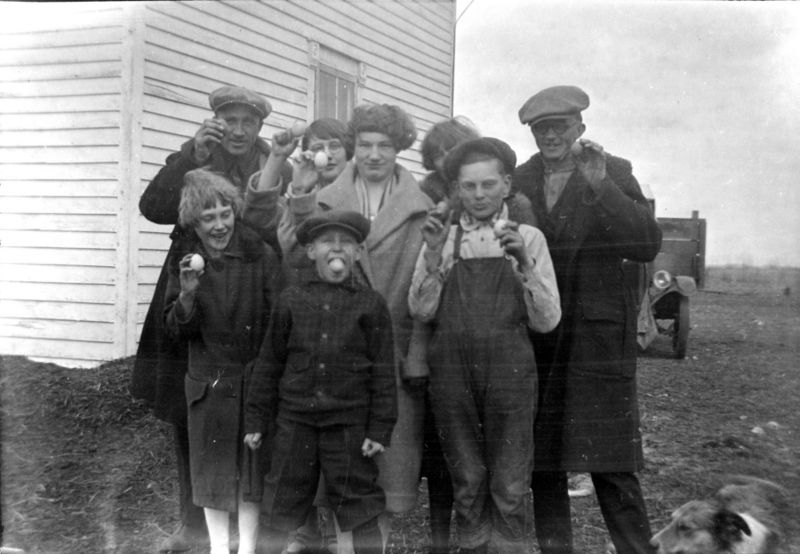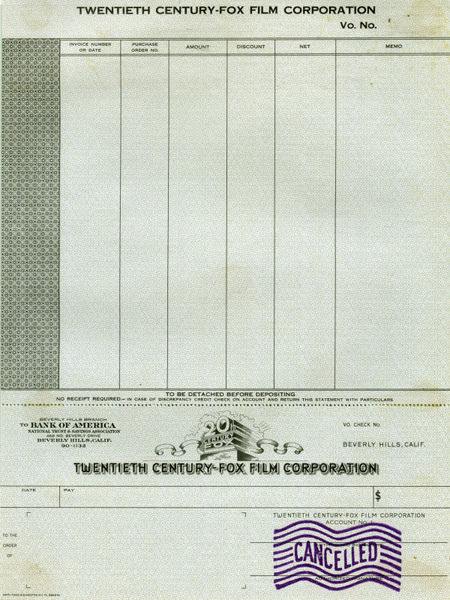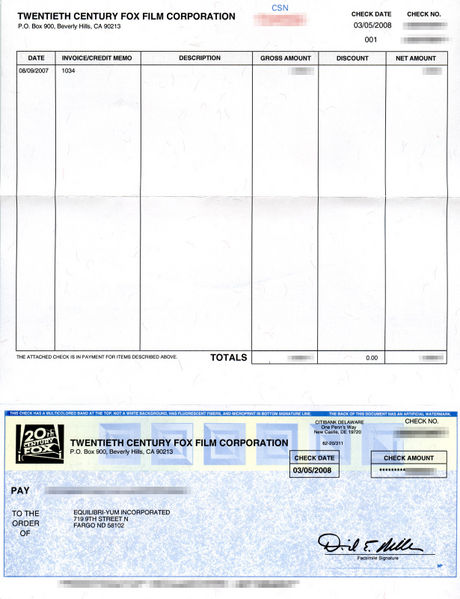 |

| |
|
|  |
Changing A Model T Tube
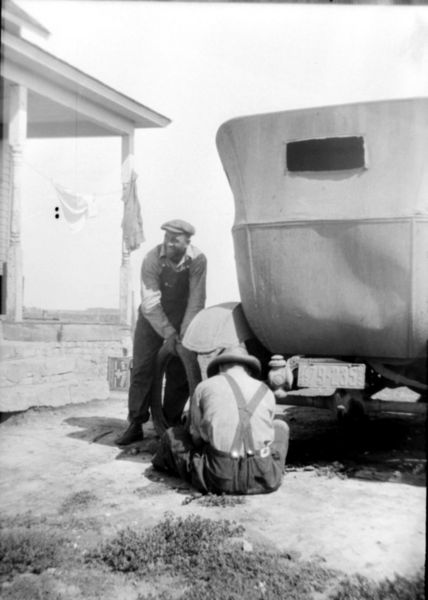 What we see here What we see here is the hindquarters of a mid-1920s Model T Sedan. The first clue is the license plate, issued in 1927, but the dented-up body would indicate that the car isn't right off the showroom floor. Aside from the year, it's pretty clearly the Ford T Sedan: the fabric top, the under-scooping back end, the fenders all echo the Model Ts of the day. In the 1920s, you had to pull the tire off the rim on a regular basis, for the same reason modern bicyclists are skilled at the same task. Car tires of the day had an inner tube, which had a habit of bursting from time to time. It was far more common in the cars than in bicycles, as the Ts covered more land, were heavier, and hit things at faster speeds than a bike. Travelers without a spare tube were in for a tough time. When you're on a cow-trail road, five miles from anywhere, no phone, no nothing, you had to fend for yourself. These guys were in luck: they were close to a house, and probably the advantage of a full toolkit from the farm's shop. They both also look familiar with the process, and probably had it done lickety-split. A sidenote on the Model T itself: As these photos are from Western Minnesota, this car was probably assembled, by hand, at the Ford Manufacturing Plant in Fargo, North Dakota. In the 1910s, Ford's expanding influence meant that they could no longer economically manufacture cars in Detroit and ship them by rail -- assembly plants were built all around the nation 1914, building cars for their local region. Fargo's opened in 1914 and was going full-steam by the time the car above was sent out into the Red River Valley's prairie farmland. Labels: 1920s, 1927, auto repair, automobilia, ford, inner tube, model t
The Racecar of Typewriters
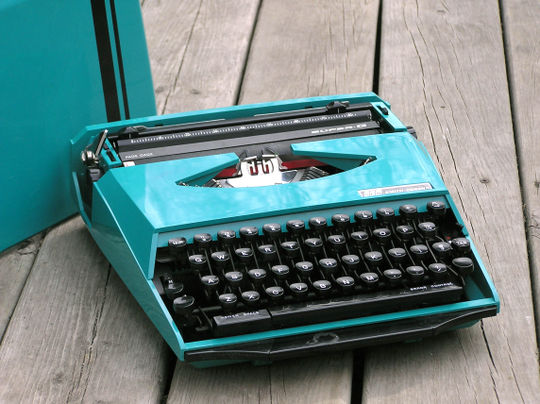 In 1970, two prominent companies within their respective industries came together to produce the item on the right. Smith Corona had been producing typewriters and other office equipment since the 19th century. Ghia Design was changing the European automobile design world by creating speedy shapes for manufacturers, most notably the Karmann Ghia. The "Super-G" wasn't revolutionary in its interior; the mechanics were standard portable-typewriter parts seen in numerous other SCM models. The most notable design features are on the closed-case cover: striking, vibrant colors (turquoise or orange), a racing stripe, and the Ghia logo. I initially thought that Smith-Corona may have simply licensed the Ghia name, but the bold "DESIGN BY" in the logo seems to verify that some designer in need of a pet project was taken away from cars and handed a typewriter design handbook. There is a bit of a disconnect between the interior and the exterior of the typewriter. The cover has straight, speedy lines with softly rounded corners, much as you'd find on a car. The interior, however, exhibits the sharp modernism that was approaching through the 1970s and 80s. One might equate it with the Ghia concept cars that followed shortly thereafter. In the coming years, Ghia was bought by Ford, and Smith Corona found that mechanical office equipment was ending up in the landfills. Ghia still makes cars, but rebranded Ford models; Smith Corona still puts text to paper, but in a more computerized way. For a short time, however, the unlikely pair managed to make the nearing-obsolete typewriter technology look like it could hold it's own in the Grand Prix. Labels: 1970, 1970s, ghia design, smith corona, typewriter
Little Eddie Schafer and His Dad
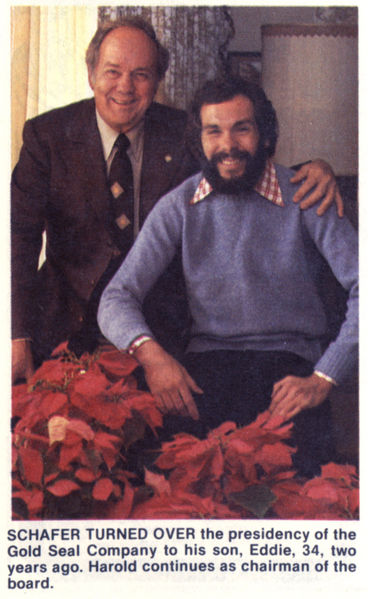 " Eddie" over there on the right, has a tough road ahead of him -- despite his shaggy appearance and obese lapels, he's got big shoes to fill. His dad, a prominent North Dakota businessman, had appointed Eddie to be his successor in taking over the family business. How do you think Eddie did? Would a guy named "Eddie" ever do well in any career other than car sales or running a pawn shop? As president of Gold Seal, Eddie was in charge of the Mr. Bubble fortune, but it didn't take long to drop the childish suffix. Harold Schafer's son, now just "Ed Schafer", went on to be North Dakota's governor for most of the nineties -- only 11 years after this photo was taken. He remained politically active after his term, and just recently George W Bush appointed Schafer to the position of Secretary of Agriculture. Here, have a look at Eddie today: he's come a long way from a goofy smile and gingham dress-shirts. Labels: 1980s, 1981, ed schafer, north dakota
Perry Como's Wanted Poster
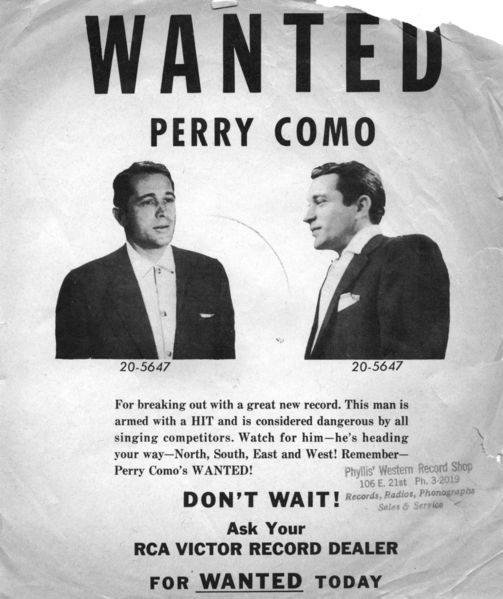 In 1954, Perry Como released " Wanted" on a 10-inch 78, with " Look Out Your Window" as the B-side; both went up in the charts quickly with Wanted hitting #1. Despite Como being in the prime of his career, RCA made sure the word got out and released this promotional flyer, perfect size for slipping in the 10" record sleeve of Como's other albums. Como is accused of the horrendous crime of 'breaking out with a great new record' -- something 'dangerous [to] all singing competitors'! Accusing the white-bread, good-natured Como of a crime was a playful turn, but a bit different from the song: Wanted's lyrics addresses a woman's criminal act of finding her way into another man's arms. It seems everyone was engaging in criminal activities! The final line of Como's crimes uses a apostrophe pun. It could mean, depending on whether the apostophe is a contraction or a possessive, either "Remember -- Perry Como is Wanted", or "Remember Wanted, by Perry Como." That number under Como's name? It looks like it could be the number off his jailhouse uniform...but it is, in fact, RCA's catalog number for the Wanted record. As a sidenote, I tried to track down Phyllis and her Western Record Shop. Sadly, I have no way of knowing where she was located. I got this flyer exactly how it was intended -- stuffed in a 78 of one of Como's other early-fifties albums -- but it was purchased from a travelling Texan antique show dealer, so Phyllis could have been dealing in phonographs anywhere from here to Amarillo. Labels: 1950s, 1954, advertisement, perry como, record album
Angelo's Atom Bomb
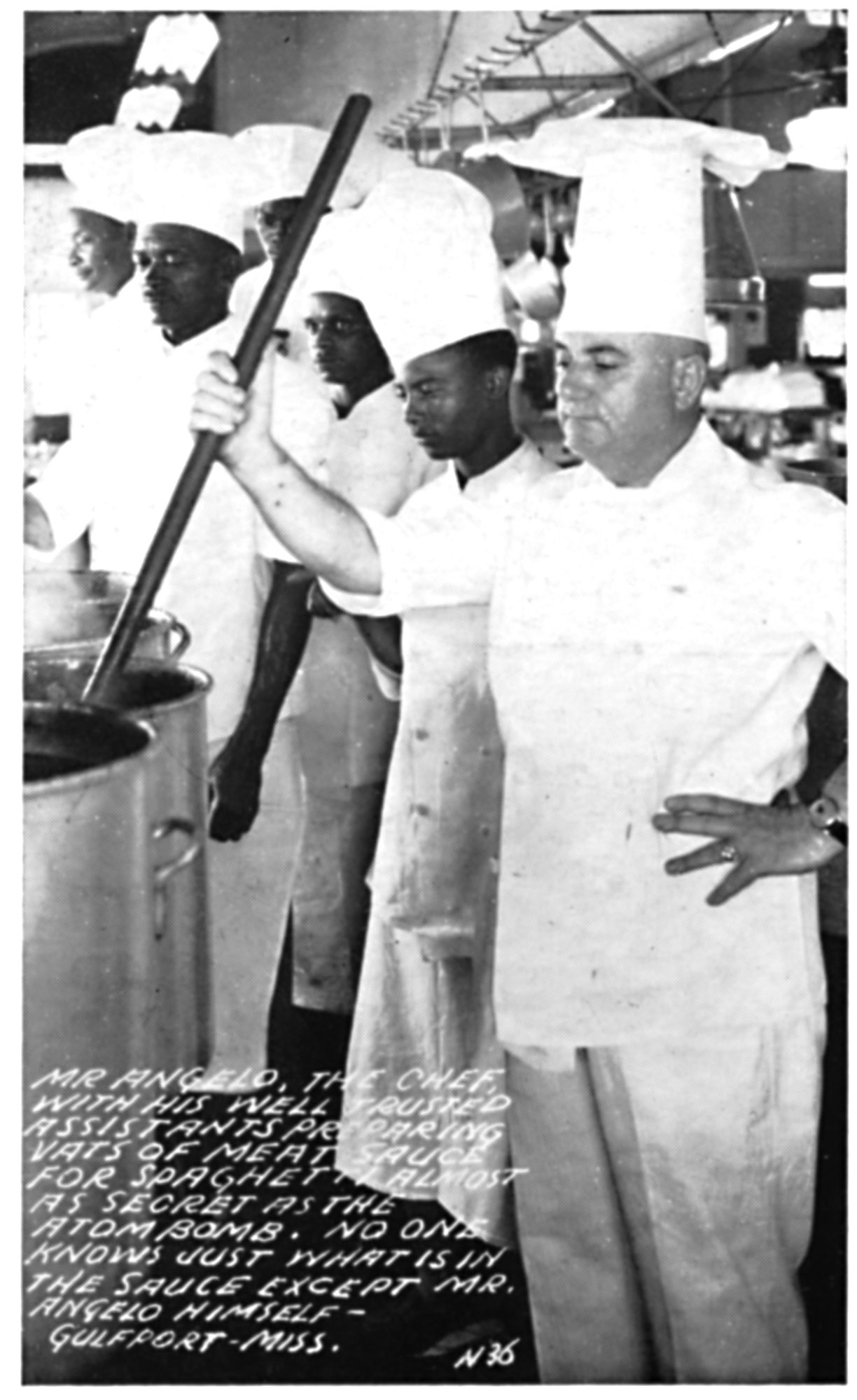 We've met Angelo before We've met Angelo before, a young immigrant who made himself a celebrity chef in the 1930s. In this postcard, a Mr. has been added as a sign of professional respect, but also in a style my wife has seen used in Greek restaurants -- "Mr" being formal, but the use of the first name being more casual and inviting from someone whose food you trust enough to eat. By the time this postcard was created, his fame and power had reached a world-shattering degree: the caption states that his recipe for spaghetti meat-sauce was " almost as secret as the atom bomb." Note that it doesn't use the Bomb as a comparison for quality of strength (although I'm sure, in modern terms, it was 'da bomb'), but instead comparing to the secret. This helps place the age of the post card a bit better: I'd previously figured this was 1940s, and since the postcard alludes that the atom bomb (first tested in 1945) was still considered a hidden secret known to only the U.S., this postcard may be from as late as 1950 but probably not much after. I also must remark (probably in the naivetie of a Northerner) that I am impressed both postcards show Angelo's staff to be composed entirely of Black chefs. While they're referred to as 'assistants,' in the cooking world where the chef whose name is on the sign over the door is par to a king in a restaurant kitchen it's still quite a title. For his assistants be used as a key portion of the restaurant's advertising, both in the photo and referenced in the text on both cards, must show Angelo saw the importance of his staff both in the kitchen and to the rest of the world, rather than devaluing them as just the negro help. Labels: 1940s, angelo's place, gulfport, mississippi, restaurant
Bud's Chicken Take-Out
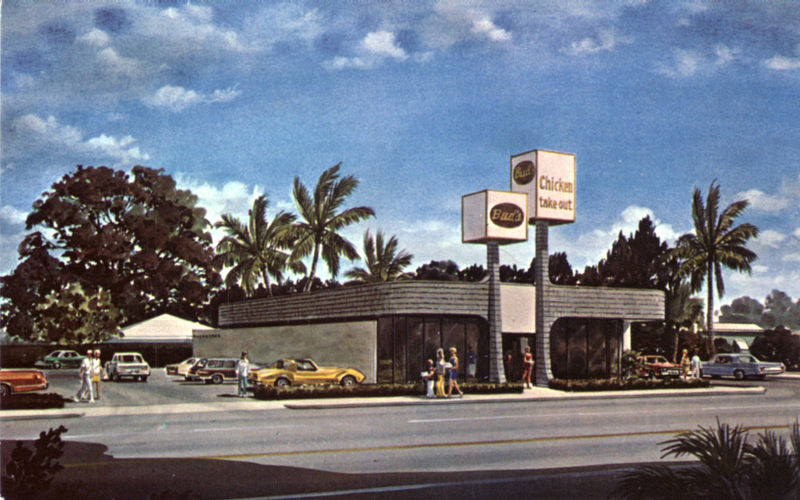 Bud's, according to their website, has been in the takeout business since 1957, slingin' food from one location until 1976. This postcard, I believe, is that second location -- it's not a photo, but an artist's rendering: those people look a bit too mannequinny for to be real, copied right out of Entourage. The design is very seventies, composed of futuristic curves, floor-to-ceiling windows, and smooth lines, combined with the ecologically-friendly wood shingles and lots of plants in the decor. The signs mimic the palm trees in the background, rooted trunks sprouting from the ground and narrowing towards the top, but terminating in huge, mostly-empty cubes proclaiming the product available. According to the back, this location sprouted up at the corner of Worthmore and North Dixie Highway, catering to the "tremendous population growth" in South Florida. Bud's has grown to seven locations, but they're not at 2200 N Dixie anymore...that location has become a Dunkin' Donuts. Labels: 1970s, Bud's Chicken Take-Out, Florida history, restaurant
Bob, Flipo, and Elmer
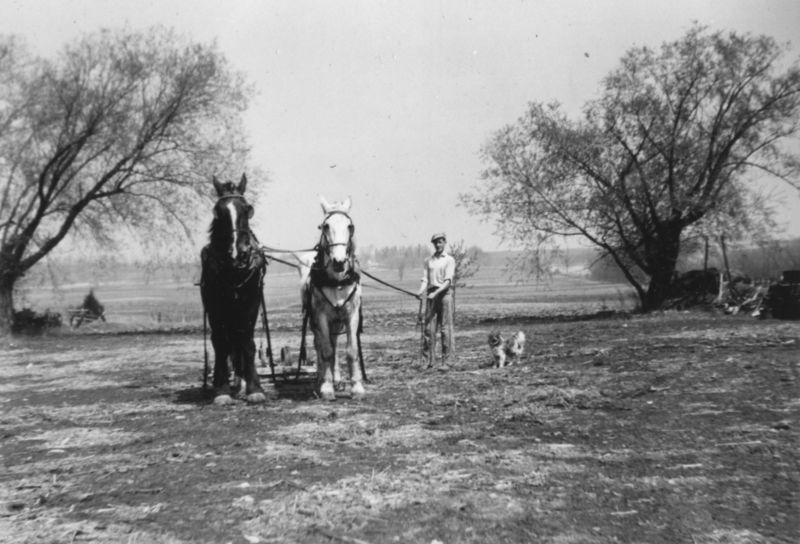 This photo was titled, " Bob, Flipo, and Elmer." However, we've got four entities in the photo: Two horses, a man, and a dog. So, who's who? Elsewhere in the album, we've met an " Elm", which is probably short for Elmer, and a Brownie, that looks a bit like this dog. So, that means the horses are named "Bob" and "Flipo." What are Bob and Flipo doing? It looks like they're hitched to a drag of some sort, scraping the surface of the ground to turn the turf under and either prepare it for planting, or just turn the weeds under so they don't become too unmanageable. Labels: 1930s, 1938, farming, horse names, wisconsin history
Salvador Dali Bloopers
*warning - artistic nudity in links*
In the 1940s, Salvador Dali and Philippe Halsman teamed up and produced a number of surrealistic works of photographic art -- some are iconic, like In Voluptas Mors and Dali Atomicus, but the pair produced many different photos during their collaboration. Others, like this one (I was unable to find its title) and Midsummer Night's Mare, made it to film but did not achieve the acclaim that Mors and A tomicus did. It's easy to forget, when seeing the final results of such a mixing of the minds, that great art isn't a coincidence or a singular act -- producing art requires practice, numerous mistakes, and attention to detail that makes the final product look effortless. The Fall 1950 issue of Photography Workshop stripped away a veneer of that pseudo- effortlessness. In an extensive article about Halsman, they included four 'outtakes' from Atomicus, the unnamed photo above, and another unnamed photo I could find no other source for: 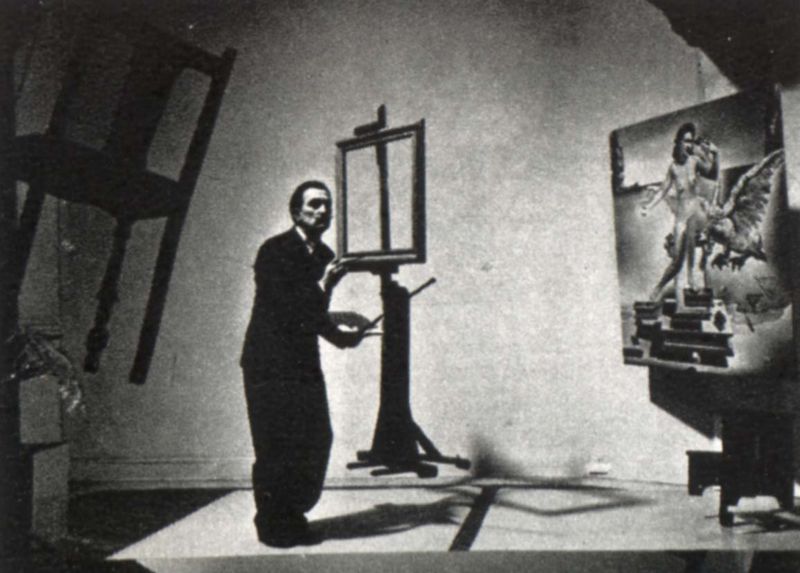 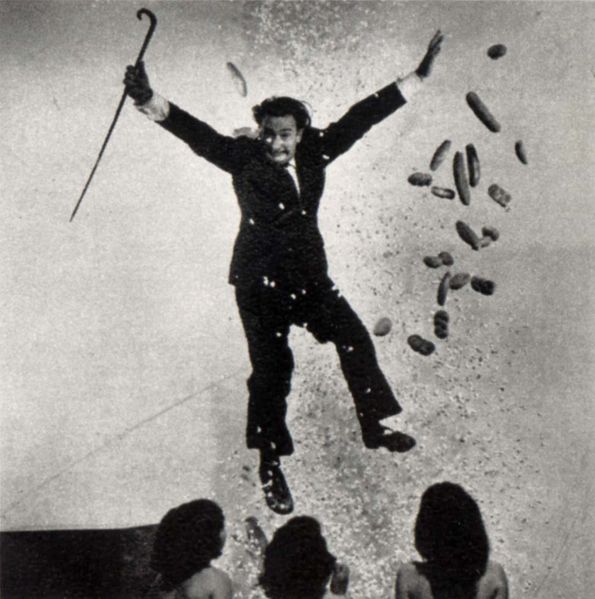 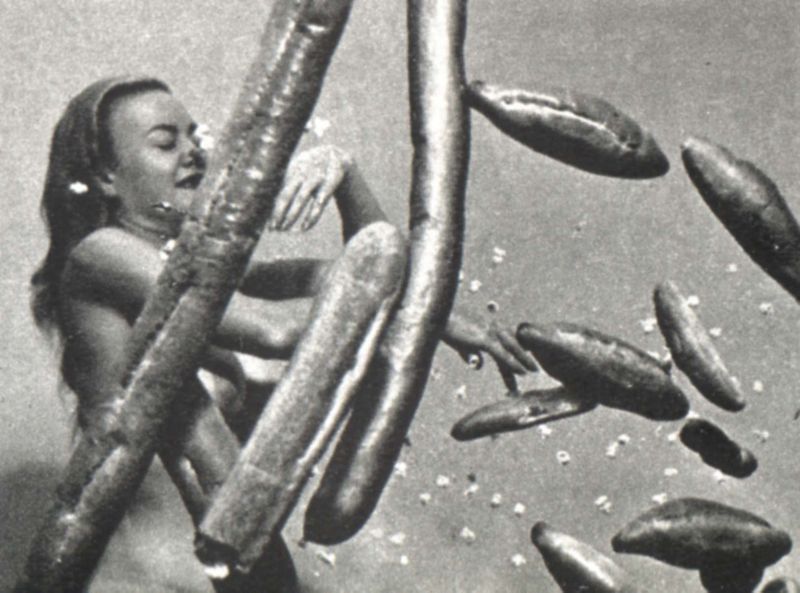 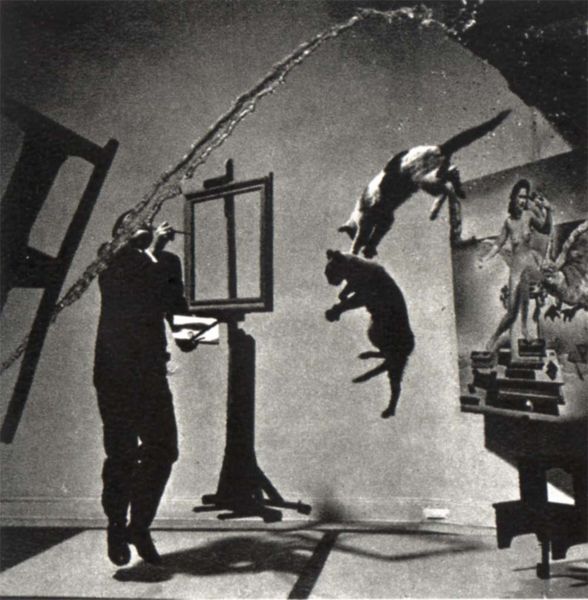 The Atomicus photo, the most famous of the Halsman/Dali colaborration, took 28 takes -- "after each exposure, while the assistants mopped the floor and reclaimed cats, Halsman developed the film to see the progress in the composition. Accidents would happen. The water, intended for the cats, would cover Dali's face instead."Labels: 1940s, 1950s, creative process, Philippe Halsman, photography, salvador dali
Forgotten Negro Books, Remembered Online
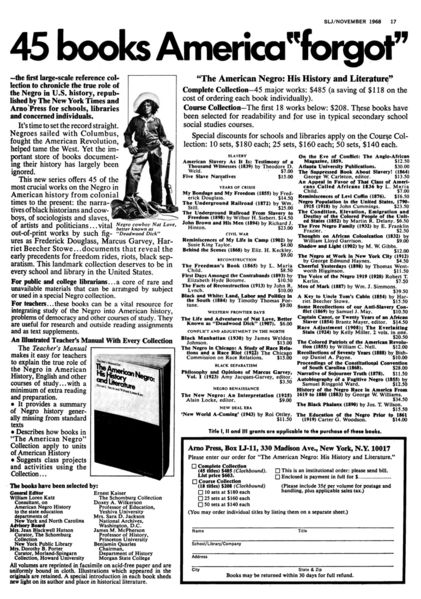 This advertisement This advertisement appeared in the November 1968 issue of School Library Journal; I'd wager that "forgot" is in shock quotes because they weren't truly forgotten (Sojourner Truth, Uncle Tom's Cabin, etc), but for the most part the books in this collection were somewhat obscure, given the subject matter and the educational system at the time. Negros were barely considered second-class citizens even in 1968 (just a couple years before I was born), so "forgot" can also apply to schools who neglected to include Negro history on their bookshelves among the Anglo-centric histories that are our libraries are still overly heavy with. This expansive collection would definitely prove to be an encompassing addition to a library, giving the probably Negro-lax knowledge of the librarians a break, removing their need to research and compile a list. Here it was, all lumped together, ready to be purchased as a $485 chunk. It'd probably look good on the budget request; to the probably overly-white adminstrative groups overseeing library acquisitions at the time, one $485 one-time purchase would look better than 45 individual purchases spread out over months as the books are discovered. Here's why Google Books, Project Gutenberg, Print-On-Demand, and other electronic publishing services are instrumental in modern education: The list of "forgotten" books are hardly forgotten today. Where, forty years ago, a library had to find nearly $500 -- probably a months' salary for one good librarian, or a half-dozen part-timer circulation desk workers -- nearly all of the books are available online today, most free to anyone with an internet connection...which, incidentally, is free in most libraries today. - American Slavery As It Is: Testimony of a Thousand Witnesses, by Theodore Weld (Google);
- My Bondage and My Freedom, Frederick Douglass (Google);
- The Underground Railroad, William Still (Arnold Bernhard Library);
- The Underground Railroad from Slavery to Freedom, Wilbur Siebert (Google);
- John Brown and His Men, Richard Hinton (Google)
- Reminiscences of My Life in Camp, Susie King Taylor (Google)
- Behind the Scenes, Elizabeth Keckley (Google)
- The Freedmen's Book, L Francis Child (Google)
- First Days Amongst the Contrabands, Elizabeth Hyde Botume (none at this time)
- The Facts of Reconstruction, John Roy Lynch (Google)
- Black and White: Land, Labor, and Politics in the South, Timothy Thomas Fortune (Google)
- The Life and Adventures of Nat Love Better Known as "Deadwood Dick" (UNC-Chapel Hill)
- Black Manhattan, James Weldon Johnson (Not Public Domain/in print)
- The Negro in Chicago: A Study of Race Relations and a Race Riot, Illinois Chicago Commission on Race Relations (Google)
- Philosophy and Opinions of Marcus Garvey, Amy Jacques Garvey ed. (not public domain/in print)
- The New Negro, Alain LeRoy Locke (not public domain/in print)
- 'New World A-Coming', Roi Ottley (not public domain/in print)
- On the Eve of Conflict: Anglo-African Magazine (not available)
- The Suppressed Book about Slavery!, George W. Carleton ed. (not available)
- An Appeal in Favor of that Class of Americans Called Africans, L. Maria Child (Google)
- Reminiscences of Levi Coffin (Google)
- Negro Population in the United States 1790-1915, John Cummings (not available)
- The Condition, Elevation, Emigration, and Destiny of the Colored People of the United States, Marin Delany (Gutenberg)
- The Free Negro Family, E. Franklin Frazier (not public domain)
- Thoughts on African Colonization, William Lloyd Garrison (Google)
- Shadow and Light, M W Gibbs (Google)
- The Negro at Work in New York City, George Edmund Haynes (Gutenberg)
- Cheerful Yesterdays, Thomas Wentworth Higginson (Google)
- The Voice of the Negro 1919, Robert T, Kerlin (Google)
- Men of Mark, Wm J. Simmons (Google)
- A Key To Uncle Tom's Cabin, Harriet Beecher Stowe (Google)
- Some Recollections of our Anti-slavery Conflict, Samuel J. May (Google)
- Captain Canot, Or, Twenty Years of an African Slaver, Brantz Mayer ed. (Google)
- Race Adjustment: The Everlasting Stain, Kelly Miller (not public domain/in print)
- The Colored Patriots of the American Revolution, William C. Nell (Google)
- Recollections of Seventy Years, Daniel A Payne (UNC-Chapel Hill)
- Proceedings of the Constitutional Convention of South Carolina (Google)
- Narrative of Sojourner Truth (University of Virginia)
- Autobiography of a Fugitive Negro, Samuel Ringgold Ward (UNC-Chapel Hill)
- History of the Negro Race in America from 1619 to 1880, George W Williams (Google)
- The Black Phalanx, Jos. T Wilson (Google)
- The Education of the Negro Prior to 1861, Carter G Woodson (Gutenberg)
Why did I mention Print-On-Demand? The 1968 editions advertised here from Arno Press, particularly the non-public-domain-editions, are still shown as available according to Amazon via Ayer Publishing with a 1-3 week wait. That sort of wait time, the type of business Ayer runs, and the existing 1968 publishing date means that this book, when ordered from Amazon, is printed in an instant on high-speed printers, bound and jacketed, and then shipped out in one constant motion. These modern technologies make available books that were once obscure and elusive. Once upon a time, you had to be a librarian with a big budget. Today, these books are available to anybody, in a comparative (or literal) instant, thanks to computers and publishing revolutions. Labels: 1960s, 1968, negro, print on demand, public domain, publishing
San Francisco, via Gray Line
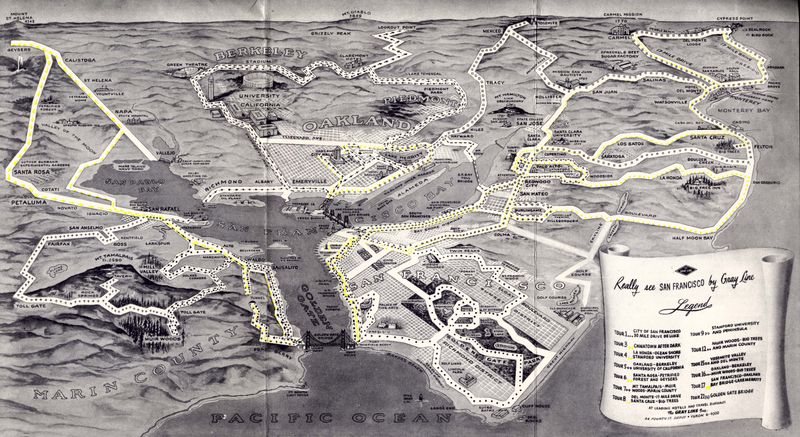 San Francisco still has Gray Line offering bus tours of their beautiful city, all these years later. The map above is from 1953, from a pamphlet called "Really See San Francisco." I'm just including the map here, but the rest may follow someday. Nearly 60 years ago, here's what the attractions via a bus tour were: - Deluxe 30-mile drive around San Francisco
- Chinatown After Dark
- La-Honda, Ocean shore, and Stanford University
- Oakland, Berkeley, and U of Calif.
- Santa Rosa, Petrified forest and geysers
- Mt Tamalpais, Muir Woods, and Marin County
- Del Monte, Santa Cruz
- Stanford University and peninsula
- Muir Woods, big trees, and Marin County
- Yosemite Valley and Del Monte
- Oakland, Berkeley, Muir Woods, big trees
- San Francisco, Oakland, Bay Bridge, Lake Merritt
- Golden Gate Bridge
All you had to do was dial Yukon 6-4000, and you could hit the road in style! I'm impressed that Del Monte was such a large part of the various tours -- post WWII, it had mostly been taken over by the Navy School, although all the land around the hotel was full of gardens, woods, and golf courses, still accessible to tourists at the time. "Chinatown after dark" is an interesting name: while the tour, given the clientèle of city bus tourists, was probably quiet and unoffensive for the time, I wonder if it was tied-in to the movie of the same name from 1931. As for the map itself: I'm a fan of purposeful maps, ones that don't spare the information about what it feels relevant, but ignores the irrelevant whenever possible. This isometric view includes landmarks and gives a nice sensation of distance, which then also lets riders know how much time will be spent looking out the window at non-landmarks. Labels: 1950s, 1953, california history, gray line, maps, san francisco
The Red River Mall
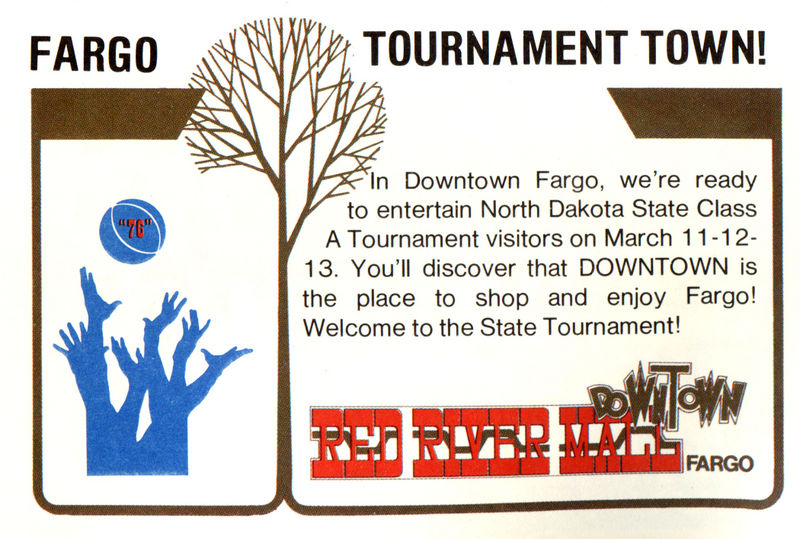 I remember the "mall" from my youth, but it barely registers that it ever actually had a name. The Red River Mall was a misguided attempt to revitalize Fargo's downtown, which (whether directly or indirectly) led to downtown Fargo's near-collapse in the late 80s and early 90s, and forcing the renewal plans that threaten to cause another Red River Mall-like slump. In the 1960s and early 1970s, the nationwide Urban Renewal movement hit Fargo and Moorhead: Moorhead got an actual indoor mall to replace the dozens of retail stores and apartments downtown. Fargo got tall buildings, open spaces, and the Red River Mall. The Mall wasn't a direct knee-jerk reaction to the creation of the West Acres Mall, but it was hoped to counter the movement of stores away from the downtown area. Fargo's retail center stretched from around 8th Avenue north to 5th Avenue South, and extended east to around 2nd Street and west to 10th Street. Modern Fargoans may be wrinkling their brows at this range, wondering how downtown Fargo was ever that big: today, Downtown starts at 6th Avenue and stops at Main, and barely extends a block off Broadway. The rest of those buildings? They were replaced by modern office buildings, they burned and were paved over instead of rebuilding, they were sacrificed in favor of flood protection, they were demolished to create parking lots, and they got absorbed by their neighbors. So, by the early 1970s, Downtown Fargo was in a poor position: it had a number of department stores, but its retail influence was shrinking. Small malls were popping up at the edges of town where new houses were being built. And then, West Acres gave the department stores the final boost to move out. That left large, empty buildings, struggling locally-owned stores, and a loss of shoppers. The city, in its infinite wisdom, saw the possibility of turning Downtown Fargo into something akin to Nicollet Mall in Minneapolis. Here's how the plan went: Broadway, formerly two lanes with parking along all sides, would be turned into a winding, parking-less, snake-like street emulating the curvy nature of the Red River. Keeping to the curvy road, large cement pylons would mark the borders. To appeal to pedestrians, at their appropriate places along the "river", marble place-markers represented the border cities. To keep rain and snow off pedestrians, overhanging roofs would line the street close to the buildings. Trees remained, or were planted for aesthetic reasons, with nice sitting places scattered throughout. As you might guess, with the loss of large stores shoppers weren't going downtown much, and now that Broadway was difficult to navigate they were less likely to do so. Sidewalk ceilings helped some, but weren't enough encouragement. The Red River Mall eliminated a lot of downtown parking, which caused more buildings to disappear from along the streets, further reducing retail spaces in exchange for mostly-empty parking lots. In 1976, optimism was still high: the Red River Mall was still an attraction. It was only a year or two after West Acres' debut, so there was less evidence of replacement, as opposed to an expansion of retail opportunities. Downtown stores hoped that regional events like the basketball tournament would draw shoppers to our repackaged 'shopping mall' and stop by. Eventually, it became clear that the Red River Mall was nothing more than shiny wrapping paper on an unwanted, regifted chotchke: even its name slowly dropped out of popular use, and Broadway's retail influence all but stopped. Labels: 1980s, 1982, broadway, fargophilia, red river mall
Horsing Around in the 1930s
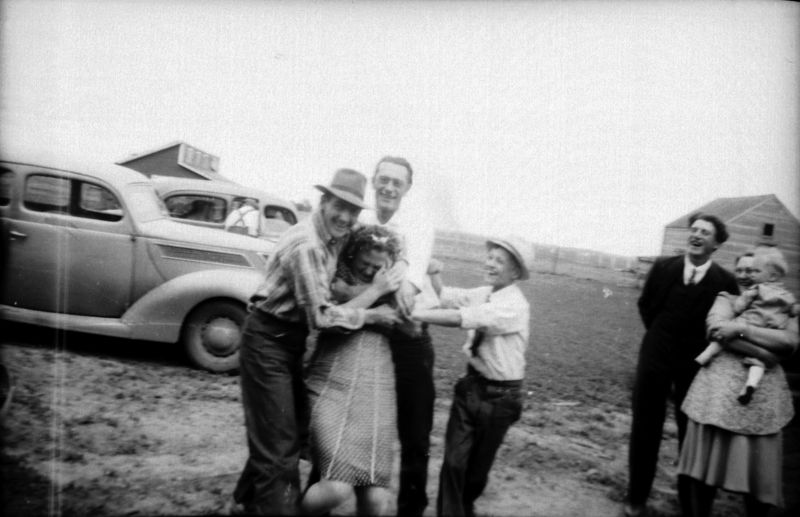 This image was poorly exposed and blurry This image was poorly exposed and blurry; I had to squeek out as much as I could using Photoshop -- I'll bet the young lady being tortured in this photo was happy to see that this photo didn't turn out originally...but she had no idea that 70 years later somebody on a computerized internet would blog about it (I'm not sure she could even parse that last phrase.) I personally love the unposed, candid photos like this one: look at what has been tossed out because it was unfit for photo albums; today is even worse, when you can completely delete an image, permanently, without thinking twice. People who stick to stiffly posed photos are missing out on the vibrant art that can come from an unplanned, quick and dirty photo. The photo above has so much going on in it -- the wrestling in the foreground, and what are they stealing from her? The friendly grouping on the far right, who look like they might otherwise not be photographed as in that same grouping because there's no logical reason to do so. The guy hunched over in the distance, leaning inside an open car door. When people are posed in a stiff, unlively manner, something is lost -- I'll bet Bertha was a far more fun person than this photo would lead the casual viewer to believe. Labels: candid, minnesota history, vintage photo, wrestling
Iron Horse Tour of the Railroad Club of Chicago, 1964
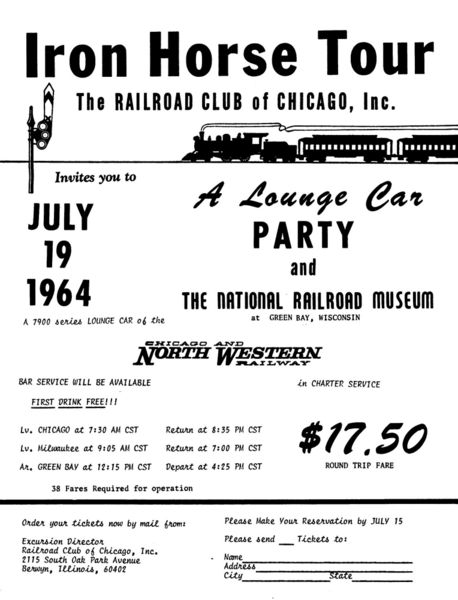 On July 19, 1964, a group of railroad aficionados piled aboard a 7900 series lounge car belonging to the Chicago and North Western Railway, en route to the National Railroad Museum in Green Bay, Wisconsin. The Railroad Club of Chicago sponsored this 'lounge car party,' bringing along friends from Milwaukee along the way, and providing one free drink in the fare. I imagine that a car-full of railroad guys -- at least 38 of them -- in a moving bar for five hours straight were a mighty friendly bunch when they disembarked in Green Bay. I'm pleased to see that the club is still around. Too often, 'archaic' clubs like these dwindle in numbers as their members age and fall away, but railroad people are an odd bunch; the romance of the rails meets men's natural affinity for huge, loud, mechanical machines, and you end up with some fun-loving guys who'll pile on a train and road-trip to Green Bay to see more trains. Today, they promote rail travel, discuss community history revolving around trains, and remind everyone that, even though trains are disappearing, they meant a lot to the United States we live in. Labels: 1960s, 1964, green bay, National Railroad Museum, railroad, Railroad Club of Chicago, wisconsin history
The Invisible Jet Fighter
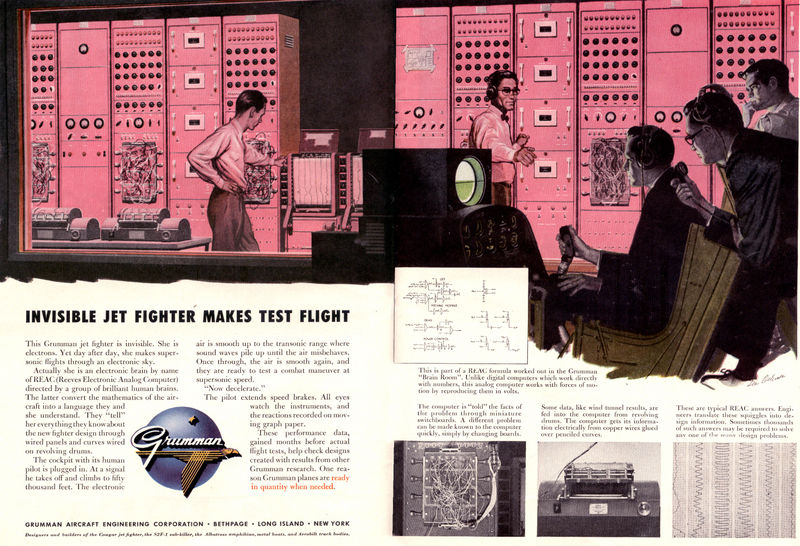 No, we're not talking about stealth fighters -- Grumman's invisible jet fighter was an example of a very early flight simulator. Using a Reeves analog computer, Grumman compiled test data using models and simulations to program the computer and 'flight-test' imaginary aircraft's data against actual flight information. Analog simulators had been around for about a decade, and digital simulators were gaining a foothold (although, as the advertisement says, Grumman didn't think much of digital simulation). Analog eventually gave way to real-time digital simulation with the Navy's UDOFT, the Universal Digital Operational Flight Trainer, which started shortly before Grumman's ad but wasn't completed until 1960. As you might guess, these projects eventually spawned imitators in the private sector, resulting in grainy, wireframe simulators -- that ran on small personal computers. Labels: 1950s, 1954, analog, computers, flight simulator, grumman, history
Maggie Magner's Get Out Of Jail Free Card
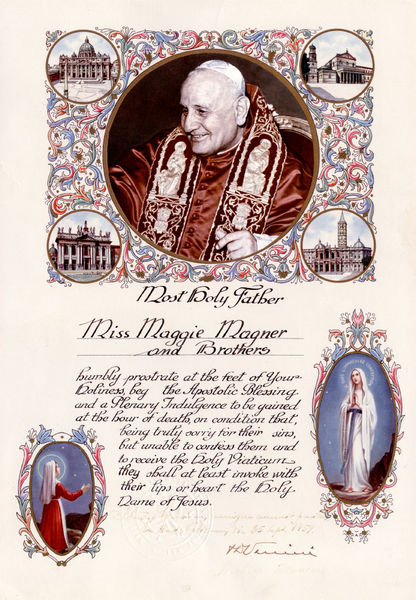 Oh, the title of this post is definitely an exaggeration: Catholicism has no 'get out of jail free' card, but the Plenary Indulgence is about as close as you can get. There's two kinds of indulgences: partial and plenary. A partial indulgence isn't much more than you get for going to confession regularly -- it covers absolution of some sins at death, providing forgiveness for the sins was achieved. Plenary Indulgences are the whole kit and caboodle: You've confessed, completed acts proving your penitence, and you've been forgiven of your sins -- mortal and venial -- and you get all of your forgiven sins left at the door upon death. In usual Catholic strangeness, it won't keep you from Hell, if you've been that bad -- it just removes the purgatory step in removal of sin. If you're that goody-goody you've qualified for a Plenary Indulgence, it's unlikely you've ever been headed South. Miss Maggie Magner, whomever she may be -- and her brothers, whomever they might be -- achieved the Plenary Indulgence on the 25th of September, 1959. I hope she wasn't too young, what with the 'Miss' salutation, because indulgences only count for past transgressions, not future sins, or else you've got to earn a new indulgence for those ones. Earning the Plenary Indulgence means that she and the siblings get " the Apostolic Blessing and a Plenary Indulgence to be gained at the hour of death, on condition that, being truly sorry for their sins, but unable to confess them and to receive the Holy Viaticum they shall at least invoke with their lips or heat the Holy Name of Jesus." This is where the traditional "death bed confession" comes in to play: people who want confession, communion (the ' viaticum'), and blessing at death are trying a last-minute end-around to cleanse them of sin. People obtaining the Plenary Indulgence are forward-thinkers: get the death-bed confession out of the way while you're nice and healthy, and all you have to do at death is have Jesus in your heart. The Plenary Indulgence has a rocky past: once upon a time, people with deep pockets would buy their salvation without having to meet the faith-based requirements. The church put a stop to that in the 16th century, but lots of people (devoted Catholics included) think indulgences were done away with at that time. Not so -- you could have earned a Plenary Indulgence last month, thanks to our Lady of Lourdes turning 150. If you thought it was funny that the church offered an indulgence for a church's anniversary in the Kevin Smith movie Dogma, don't laugh, it's completely possible -- you can earn indulgences for all kinds of things still today if the empowered person decrees it so. The rules have done away with the financial aspect, but retain the penitence and forgiveness. I was originally rather suspicious of Miss Magner's indulgence: the forgiveness of unnamed brothers who get to piggyback on Maggie's penitence (which is against the rules unless they're already dead), the lack of explanation of how she earned the indulgence, the obviously boiler-plate text...I figured it was some scam artist preying on old Catholic ladies. There is a very official embossed seal on the indulgence, containing the seal of the Holy See -- that's gotta make it Pope-approved -- from the office of "Magister Sacrarum Largitionum Pont. Max." Uh, that roughly translates to the treasurer of the Pope's income. Maybe monetary gifts do have something to do with it. I don't mean to impugn Miss Magner's intentions, but I'd hate to find out that God has a special Hell for people who try to buy a quick path to Heaven. Miss Maggie Magner's indulgence lives in a sacred place in our home: in the bathroom, above the toilet. Oh, that smiley guy in the middle? That's Pope John XXIII -- he was pope just for a couple years, dying in office (or is in situ more appropriate?) . They must've been planning for his demise, because his photo isn't printed on the Indulgence: it's a cut-out photo glued over a blank circle. Sidenote: In trying to figure out what popes occurred when, I discovered why Wikipedia is such an excellent resource: they have a list of sexually active popes. Sadly, there haven't been any in a couple hundred years...but we can always hope! Labels: catholicism, certificate, plenary indulgence, religion
Fallout Protection for Homes With Basements
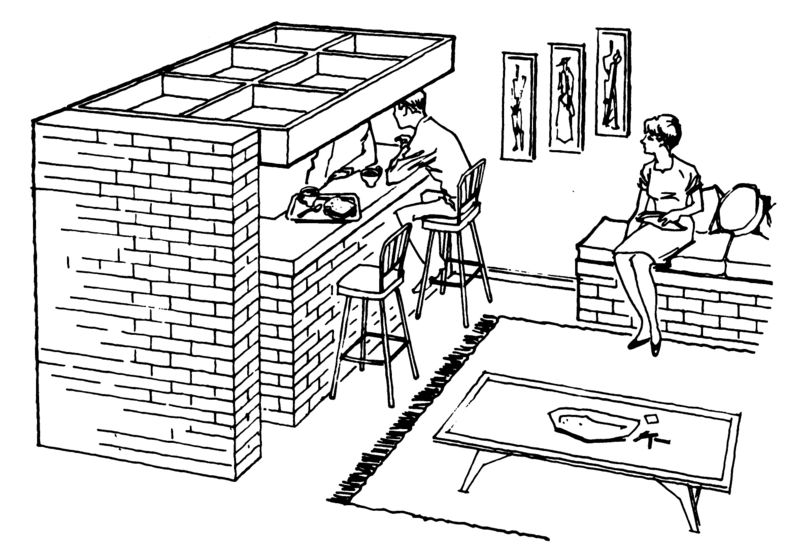 That swanky snack bar isn't a weekend project from Handy Andy -- it's secret is that the instant the Emergency Broadcast System begins to pierce the air, the snack bar converts into a fallout shelter. The booklet " Fallout Protection for Homes with Basements" -- available in online and hard-copy formats, was produced by Civil Defense and mailed out to homeowners who completed a questionnaire about their house's construction. Based on those answers, using an ' electronic computer', the CD calculated how much radiation protection your unshielded basement can provide...and offer a lot of advice on what to do if your basement comes up short. Unlike the traditional image of a fallout-shelter as an impenetrable fortress buried in the back yard, these fallout shelter suggestions are practical, cheap, simple...and aren't a waste of space if nuclear war never happens (knock on wood). What surprised me is the fact that fallout doesn't behave like a gas -- it falls like snow, piles up on the ground, but it's the radiation the fallout emits that is what will get you. The fallout shelters don't have doors, and the booklet says several times that if you must go do important things (read: use the toilet), you can wander about for a few minutes at a time. If you're hiding out under a converted snack bar, at least you won't have to go far for a can of peanuts. Labels: 1960s, 1967, civil defense, cold war, fallout shelter, nuclear war, retro style
In The Bath: November 1954
 I know I've been heavy on the analysis lately, so in today's post I have nothing to say about the sink; I can't tell you about the toy the baby is playing with; I don't know where the newspaper is from, or what its articles are about; I have nothing to say about asparagus ferns being grown in drinking glasses nor the appropriate use of a roasting pan to bathe small humans. All I know is there's some 55-year-old man who probably doesn't want the whole world to see him naked....yet here he is. Labels: 1950s, 1954, baby, bath, naked, roasting pan, steel sink
20th Century Fox Money - Then And Now
On the left, a 20th Century Fox check from sixty years ago, purchased (along with 15 more pounds of 20th Century Fox ephemera from the early forties) by my wife and I for a lot of money, on the assumption we could re-sell it for a whole lot more than we paid. We've had an appraiser say it could have been worth more than a thousand dollars, were we to find the right buyer. Before a buyer found us, 20th Century Fox's legal department found us. See, the large book of Fox ephemera was lent by Fox to the University of Southern California... and was stolen from the university's library. Allegedly, entirely according to what the Fox lawyer told us on the phone. Rather than calling the police and having us hauled in for trafficking stolen materials, one of Fox's lawyers contacted us, asked us to take the paper off the market, and offered to pay us what we spent in acquiring it in the first place. A reasonable deal; we could have argued to keep it, we could have gone to court, Fox would have had to figure out how to prove that this book was the one stolen, we'd prove our ownership and the unlikeliness that it ever belonged to 20th Century Fox...but we thought it better to cut our losses. In the mail today arrived the check on the right -- a modern 20th Century Fox check reimbursing us for our expenses in holding on to this lot for Fox until UPS delivers it sometime next week. As the issue is ownership, and not protection of intellectual property, I took some scans of the cooler aspects of the lot before I ship it out in the next couple days. You'll get to see some of it soon. Labels: 1940s, 20th century fox, bank of america, check, cheque
The Hotel Del Monte
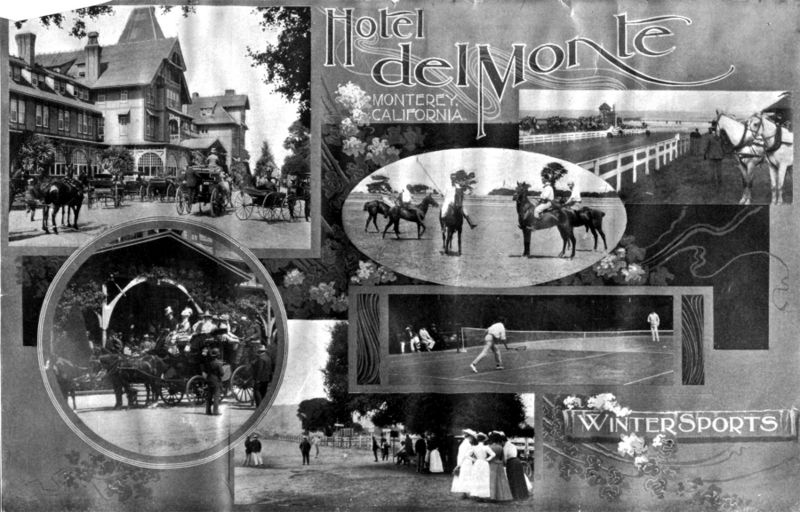 The wrinkles from the glue are disappointing, because this is such an excellent photo-montage of activities available at the Hotel del Monte in Monterey, California. Horses, it seems, were the key activity, whether they pulled carriages, were rode by fair women, or were raced against each other on a track. From the Hittel's Hand-book of the Pacific Coast in 1882: The most interesting feature of the town of Monterey, for the tourist, is the Hotel del Monte, erected by the capitalists of the Southern Pacific Railroad Company for the accommodation of visitors. It is one of the most complete buildings on the continent for the accommodation of pleasure-seekers. The length is 385 feet, the width, 115; the height, 3 stories. There are accommodations for 400 guests. The hotel has its own gas works, and is supplied with water from its own artesian well. The grounds of the hotel have an area of 100 acres, partly in beautiful garden and lawn, and the remainder wooded with oak, pine, and cypress trees. Neat by, and under the same ownership, are 7,000 acres of land, through which there are fine roads, open to the patrons of the hotel. A bathing pavilion contains four tanks, each 50 feet long and 36 wide. These are fulled with salt water which is heated to a temperature of about 70°. There are also separate bathrooms. The whole establishment is managed in the best style, and it has done much to attract great numbers of visitors to Monterey. The hotel is within a few yards of the beach, so that those who prefer to bathe in the ocean need not tire themselves by walking to reach it. The building seen above, however, was a reconstruction of the original Del Monte, which burned to the ground in 1887. The investors of the Southern Pacific Railroad spared little expense to develop the finest resort hotel in California, away from the larger cities, bordering both the forest and the ocean. The hotel expanded with new amenities like those seen above over time, and eventually passed into the ownership of Samuel F.B. Morse. Morse, already owner of Pebble Beach Golf Course, now also controlled the Del Monte golf course, the oldest golf course in the West. This also put Morse in the position of rebuilding the hotel yet again when the building pictured above burned in 1924. Could you stay at the Hotel del Monte today? You can't exactly go as a visitor, but you can walk the halls SFB Morse built if you were a Navy officer. In 1943, the wartime flight training school leased the hotel and turning it into an educational home; the Naval Postgraduate School was moved there in 1951, occupying all 627 remaining acres of former tourist grandeur. Labels: 1900s, california history, hotel del monte, monterey, naval postgraduate school
The Byelorussian Soviet Republic: 1971
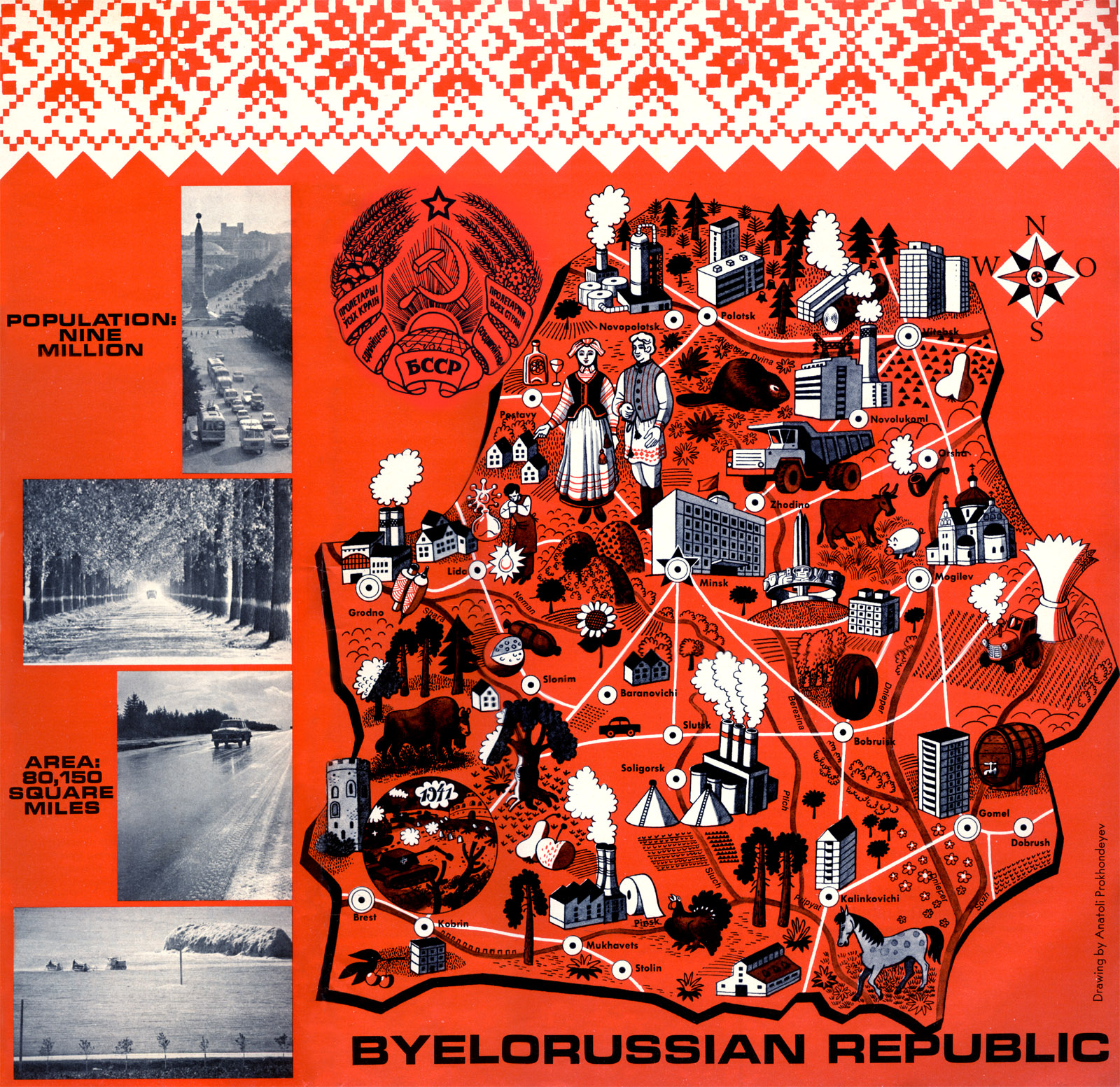 This map appeared in the front cover of the December 1971 issue of Soviet Life magazine. Soviet Life, as you might have guessed, has grown along with its namesake, becoming Russian Life today. Back in the 1970s, the magazine presented the Soviet Union in a less-than-propagandic way, avoiding too much political content and focusing on common life in the USSR. It made it into the hands of Americans, under the agreement that the Soviet regime would distribute the magazine America to citizens of Russia. In this issue, we learn of Belorussia's contributions to the world, its participation in WWII and the United Nations, and its advances in arts and sciences. Most all of the article content can be found condensed into this illustrated map, showing off everything from classic styles of dress to cheese to construction equipment. The big logo in the middle is the Soviet-era symbol of Belarus, slightly different from an earlier style (which in turn was based on a general Soviet symbol): today's symbol is strikingly similar, but exchanging the hammer and sickle for their own nation's outline. While retaining some Soviet symbolism, the country changed its name from the Soviet-sounding "Belorussia" to "Belarus" with their independence. Labels: 1970s, 1971, belarus, maps, soviet, ussr
Ever-Expanding Fargo
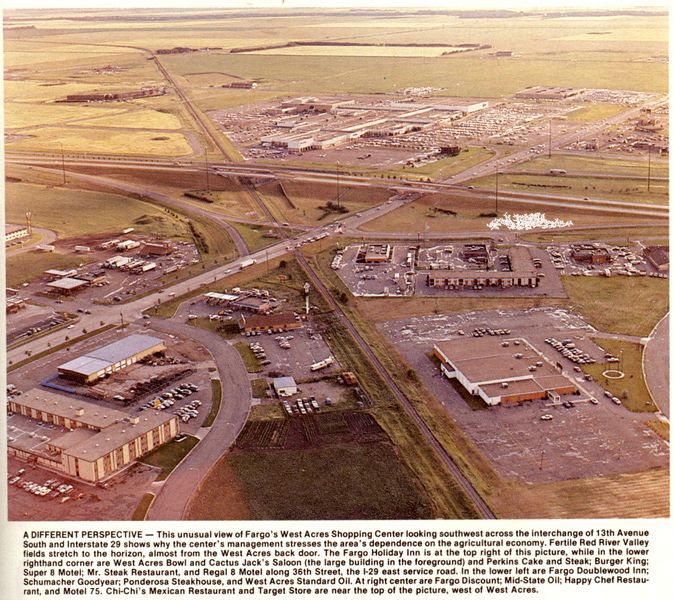 If you had no idea that Fargo has grown in leaps and bounds, let's look back 25 years. In 1982, this photo was taken for the Binford Guide to commemorate the 10th anniversary of West Acres Mall. The mall is seen in the upper-center area of the photo -- and beyond that are miles and miles of farmland. 45th Street, barely visible at the top edge (it was a dirt road then) is about a mile from I-29: today ( see a Google Map), the green, lush farmland you see is almost entirely paved and filled with a zoo, the YMCA, the largest Scheels store in the world, a 6-story office building (in which the Infomercantile webserver lives), and numerous other offices, strip malls, big-box retailers, and apartment buildings. The growth of the Fargo area is dumbfounding sometimes; when they talk about rural areas shrinking in population, it's because they're coming to the bigger cities. One thing I find most interesting, from both the photo and the aerial map, is the identification of what's new versus what's old based on the railroad line that used to run through this part of town. Buildings built on the diagonal were there before the tracks were removed; buildings on the north-south lines are new. Labels: 1980s, 1982, fargophilia, west acres mall
Hubbard's Academy of Immortals
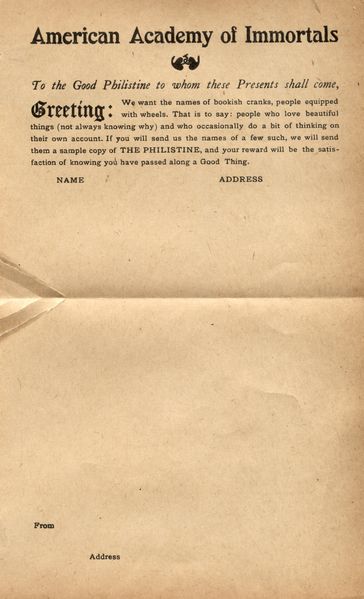 In the old days, when a nation's art and culture were monitored and controlled by the government in power, many added their greatest artistic minds to a roster called the Academy of Immortals. American popular culture in the 19th century, a young nation with a rebellious streak, prided itself on being a country of the common man: our government was chosen by the unwashed masses (artfully referred to as the "host of Philistia" by critics), our popular music -- including our freaking national anthem -- were based on barroom tunes, and our art was crude, functional, and primitive. What place does an Academy of Immortals have in our fair, young nation? By the late 19th century, it was as a cultural jab at Europe. The membership of our country's Immortals was commonly seen as open to anybody with half a mind to participate: a country of the people, an art-world of the people. Elbert Hubbard, one of my favorite people these days, called his magazine the Philistine in honor of the free-thinking common man who has no time for culture handed down by ivory towers. His subscribers could, for a $10 lifetime membership, receive whatever back-issues he had on hand, and up to 99 years of free stuff -- and each one was granted membership in his American Academy of Immortals. Not content to limit membership to existing fans, Hubbard sent out the sheet (seen on the right), to encourage his fans to turn in their buddies. What member of the proletariat did not deserve to be part of an American Academy of Immortals? Labels: american academy of immortals, elbert hubbard, roycrofters
Inside Black's Store Without A Name
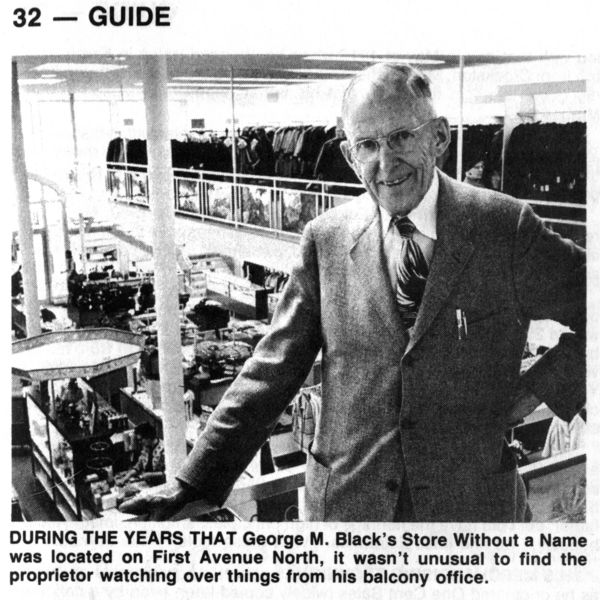 Meet George M Black. The big building on Broadway, the one sprouting up from Elm Street Square today, bear this gentleman's name. In 1912, Black opened up his own department store -- Black's -- on that spot and began buying up the surrounding property. Black sold his store to Sears and used the money to build the Black Building -- but he wasn't out of the department store racket yet. The photo above, scanned from a Binford Guide article about the sale of the Black Building in '86, is of Black overlooking his post-1929 department store. Black had sold his previous store to Sears lock, stock, barrel, and name, resulting in a guy with retail smarts but no catchy name anymore. His solution: call his new shop The Store Without A Name. The marketing was witty -- he held a contest to pick a new name, but to everyone's surprise the majority of the votes went to keep the department store nameless. One bright suggestion was to abbreviate it to the 'Swan', but that didn't have the sticking power of the unnammed shop. The Store Without A Name is now the parking lot next to the Avalon; the Black Building ceased being a department store when Sears moved out to the mall in '76. Labels: black building fargo, fargophilia, sears
Bedouins from beyond the Red Sea
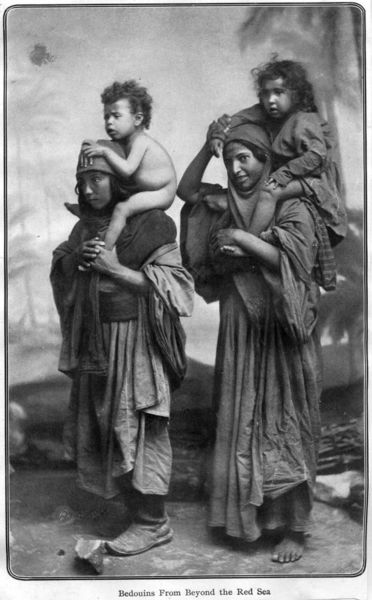 This photo This photo, from the Pennsylvania Report Scrapbook, depicts " Bedouins from beyond the Red Sea". The photo was clipped from some other source, and judging from the paper it's on and what I can see of it, the photo was cut from a magazine. As the rest of the photos are from no later than 1904, we can place it quite comfortably in the late 1800s or very early 20th century. Bedouins, as you may know, were nomadic herders in northern africa and the arabic regions. Both appear to be women, with children riding on their shoulders (the kid on the left is rather naked), while the woman on the right has no shoes. For as nomadic as the bedouins were, I'd have thought it more difficult to find some willing to stand still in front of a stock backdrop for a family photo. Labels: 1800s, bedouin, pennsylvania report scrapbook
|  |
|
|
 What we see here is the hindquarters of a mid-1920s Model T Sedan. The first clue is the license plate, issued in 1927, but the dented-up body would indicate that the car isn't right off the showroom floor. Aside from the year, it's pretty clearly the Ford T Sedan: the fabric top, the under-scooping back end, the fenders all echo the Model Ts of the day.
What we see here is the hindquarters of a mid-1920s Model T Sedan. The first clue is the license plate, issued in 1927, but the dented-up body would indicate that the car isn't right off the showroom floor. Aside from the year, it's pretty clearly the Ford T Sedan: the fabric top, the under-scooping back end, the fenders all echo the Model Ts of the day.
















